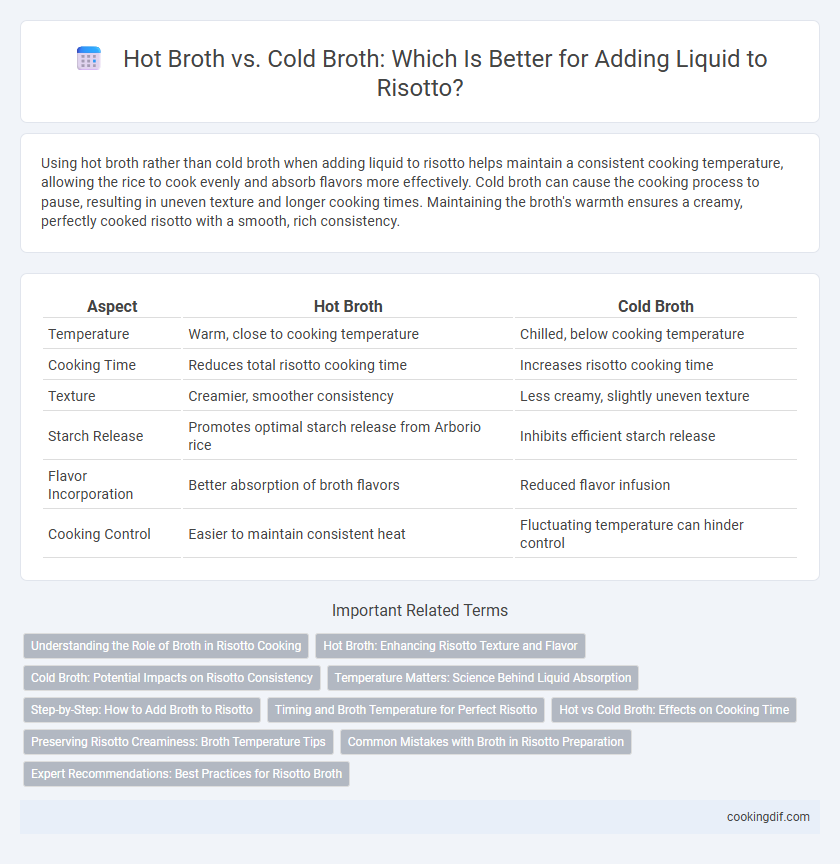Using hot broth rather than cold broth when adding liquid to risotto helps maintain a consistent cooking temperature, allowing the rice to cook evenly and absorb flavors more effectively. Cold broth can cause the cooking process to pause, resulting in uneven texture and longer cooking times. Maintaining the broth's warmth ensures a creamy, perfectly cooked risotto with a smooth, rich consistency.
Table of Comparison
| Aspect | Hot Broth | Cold Broth |
|---|---|---|
| Temperature | Warm, close to cooking temperature | Chilled, below cooking temperature |
| Cooking Time | Reduces total risotto cooking time | Increases risotto cooking time |
| Texture | Creamier, smoother consistency | Less creamy, slightly uneven texture |
| Starch Release | Promotes optimal starch release from Arborio rice | Inhibits efficient starch release |
| Flavor Incorporation | Better absorption of broth flavors | Reduced flavor infusion |
| Cooking Control | Easier to maintain consistent heat | Fluctuating temperature can hinder control |
Understanding the Role of Broth in Risotto Cooking
Hot broth accelerates the starch release from Arborio rice, resulting in the creamy texture characteristic of risotto. Using cold broth slows the cooking process and can cause temperature fluctuations, leading to uneven rice consistency. Maintaining hot broth ensures even absorption and optimal risotto creaminess, essential for authentic Italian risotto preparation.
Hot Broth: Enhancing Risotto Texture and Flavor
Using hot broth when preparing risotto ensures optimal starch release from the Arborio rice, resulting in a creamy and velvety texture. The consistent temperature of hot broth maintains the cooking process, allowing the rice to absorb flavors evenly and develop its signature rich taste. Cold broth can disrupt cooking temperature, leading to uneven texture and less integrated flavors in the final dish.
Cold Broth: Potential Impacts on Risotto Consistency
Cold broth can significantly affect risotto's consistency by cooling the rice grains during cooking, which slows down starch release and results in a less creamy texture. The temperature drop interrupts the gradual absorption process needed for optimal risotto creaminess, potentially yielding unevenly cooked grains. Warm or hot broth, typically around simmering temperature, maintains consistent heat, facilitating even starch gelatinization and a smoother, silkier finish.
Temperature Matters: Science Behind Liquid Absorption
Hot broth accelerates starch gelatinization in arborio rice, enhancing creamy texture by enabling optimal absorption and consistent heat transfer. Cold broth slows the cooking process, creating uneven gelatinization and potentially resulting in a less creamy risotto. Maintaining broth temperature around 70-80degC maximizes starch release, ensuring a velvety consistency essential for traditional risotto.
Step-by-Step: How to Add Broth to Risotto
Adding hot broth to risotto ensures the rice cooks evenly and maintains a creamy texture, as the temperature prevents the cooking process from slowing down. Slowly ladling the hot broth one cup at a time allows the rice to absorb the liquid gradually, releasing starch and creating the signature creamy consistency. Using cold broth can shock the rice, disrupting the cooking process and resulting in unevenly cooked grains and a less smooth risotto.
Timing and Broth Temperature for Perfect Risotto
Using hot broth instead of cold broth when making risotto ensures faster absorption by the rice, promoting even cooking and a creamy texture. Adding cold broth slows down the cooking process, causing uneven grain texture and a less cohesive dish. Timely addition of warm broth maintains optimal temperature, allowing the starch to release gradually and creating the signature silky risotto consistency.
Hot vs Cold Broth: Effects on Cooking Time
Using hot broth when cooking risotto significantly reduces the overall cooking time by maintaining a consistent temperature, allowing the rice to absorb liquid more efficiently. Cold broth cools the cooking surface, causing the temperature to drop and prolonging the time needed for starch release and proper rice texture development. Chefs aiming for a perfectly creamy risotto prioritize hot broth to ensure even cooking and optimal flavor absorption.
Preserving Risotto Creaminess: Broth Temperature Tips
Using hot broth instead of cold broth preserves risotto creaminess by maintaining a consistent cooking temperature, which allows the starches in the rice to release evenly. Cold broth cools the rice grains, interrupting the gelatinization process and resulting in a less creamy texture. For optimal risotto, keep the broth simmering and add it gradually to sustain the desired creamy consistency.
Common Mistakes with Broth in Risotto Preparation
Using cold broth in risotto preparation often leads to uneven cooking and extends the overall cooking time, as the rice temperature drops with each addition. A common mistake is neglecting to keep the broth hot, which causes the rice to release less starch, resulting in a less creamy texture. Maintaining a consistent hot broth ensures proper absorption and a perfectly creamy risotto.
Expert Recommendations: Best Practices for Risotto Broth
Experts recommend using hot broth when preparing risotto to ensure even cooking and optimal starch release from the rice, resulting in a creamy texture. Cold broth can disrupt the cooking temperature, leading to uneven grain consistency and extended cooking time. Maintaining a steady simmer of the broth enhances flavor infusion and allows precise liquid absorption for perfect risotto.
Hot broth vs Cold broth for liquid addition Infographic

 cookingdif.com
cookingdif.com